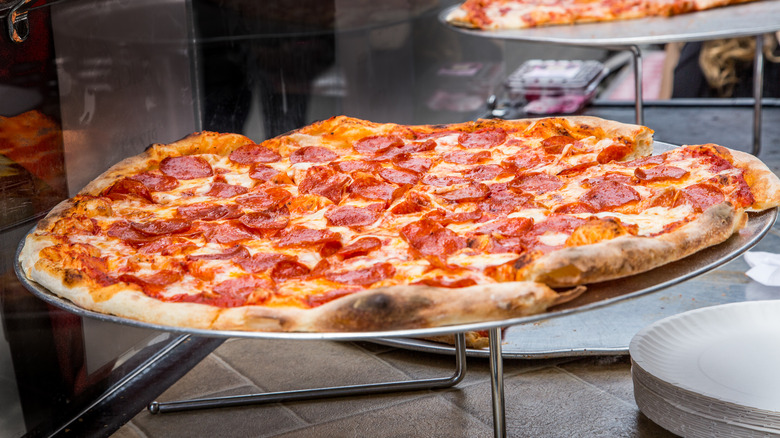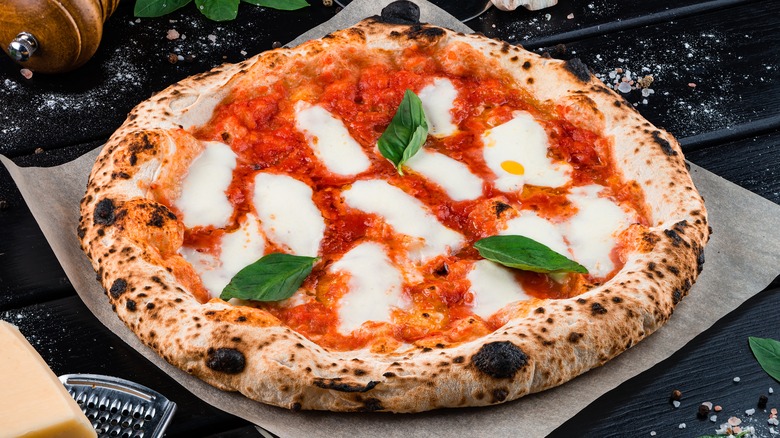American Vs Italian Pizza: How Do The Two Really Compare?
Americans like to think of pizza as our thing; along with hamburgers and chicken nuggets, pizza generally forms the third leg of the Picky Eater Triumvirate. And there's some truth to that: American pizza is an indelible part of the American landscape (though it didn't really rise in popularity until after World War II). But pizza isn't originally an American dish, as Italians love to point out.
But are Italian pizza and American pizza really different? Actually, yes; though there's some overlap (and certain American regional styles resemble Italian pizza more than others), American pizza and Italian pizza are different in some fundamental ways. There's the crust, for starters, followed by just about every other aspect that tops the pizza. You don't even eat them the same way, as Italian pizza requires a knife and fork. Really, every facet of the pizza is different aside from the fact that both are flatbreads and cheese is involved (as well as usually a tomato-based sauce).
America has tons of different pizza styles
The thing about American pizza is it isn't one style. Though many share some characteristics common with their Italian counterpart, none are exactly like their European cousins. New York-style is in many ways the classic: A large, hand-tossed thin crust designed with a pliable center so you can fold it in half and eat it. Though standard American pizza (think Domino's or Pizza Hut) doesn't quite have the same quality, it's most closely based on New York pizza.
But it's hardly the only style out there. There's also Detroit (thick, rectangular pan pizza), Chicago tavern (an extremely thin, cracker-like crust sliced into squares), Chicago deep dish (an incredibly thick, casserole-like dough with tomato sauce served on top of the cheese), Columbus (similar to Chicago tavern, but using provolone instead of mozzarella), Ohio Valley (cooked pizza topped at the end with cold cheese), and numerous other forms depending on where you go.
And the king of all American pizza forms might come from New Haven, Connecticut. Apizza (pronounced "ah-beets") consists of a high-moisture fermented crust cooked in a coal-fired oven and topped with pecorino cheese instead of mozzarella. Its apotheosis is probably the white clam pizza, which has olive oil instead of tomato sauce, cheese, oregano, garlic, and clams. It's unlike anything you can get anywhere else.
Italian pizza differs in a lot of key ways
Meanwhile, Italian pizza has different styles, but there's much less flexibility between them. Most Italian pizzas generally only have thin crusts (kind of like Chicago tavern or Columbus). The sauce is different, too: While American pizzas generally feature a slow-cooked tomato sauce with some added sugar, traditional Italian pizza sauce is cooked faster using fresh, pureed tomatoes, olive oil, garlic, and oregano. And while American pizza can feature any number of toppings, Italian pizza generally highlights either one or nothing at all. American pizza also tends to have more cheese than its Italian counterpart.
But the most significant difference might be how you eat it. You'll never get a slice of pizza in Italy; they're served whole, like a giant Ritz cracker. You're expected to cut it yourself with a knife and fork, and eating pizza with your hands would be considered highly gauche.
That said, there are a couple of regional styles that bear mentioning. Neapolitan generally has a slightly thicker crust, sort of resembling New Haven-style — though the toppings of a Neapolitan margherita feature only tomato sauce, clumps of fresh Buffalo mozzarella, and basil. Meanwhile, Sicilian pizza bears a lot of resemblance to Detroit-style, though it doesn't include mozzarella cheese; instead, it usually makes use of pecorino. Whichever form you prefer, though, there's no wrong decision when it comes to choosing pizza.


